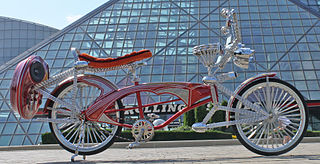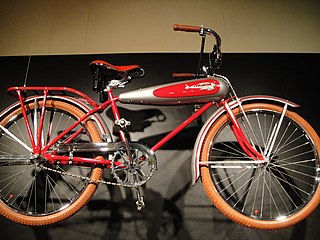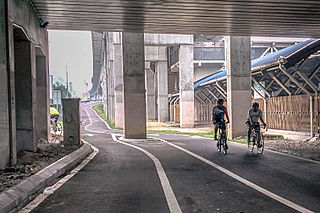
A bicycle, also called a bike or cycle, is a human-powered or motor-powered, pedal-driven, single-track vehicle, having two wheels attached to a frame, one behind the other. A bicycle rider is called a cyclist, or bicyclist.

A billboard is a large outdoor advertising structure, typically found in high-traffic areas such as alongside busy roads. Billboards present large advertisements to passing pedestrians and drivers. Typically brands use billboards to build their brands or to push for their new products.

Bicycle messengers are people who work for courier companies carrying and delivering items by bicycle. Bicycle messengers are most often found in the central business districts of metropolitan areas. Courier companies use bike messengers because bicycle travel is less subject to unexpected holdups in city traffic jams, and is not deterred by parking limitations, fees or fines in high-density development that can hinder or prevent delivery by motor vehicle, thereby offering a predictable delivery time.

A bicycle-sharing system, bike share program, public bicycle scheme, or public bike share (PBS) scheme, is a shared transport service in which bicycles are made available for shared use to individuals on a short term basis for a price or free. Many bike share systems allow people to borrow a bike from a "dock" and return it at another dock belonging to the same system. Docks are special bike racks that lock the bike, and only release it by computer control. The user enters payment information, and the computer unlocks a bike. The user returns the bike by placing it in the dock, which locks it in place. Other systems are dockless.

Road cycling is the most widespread form of cycling in which cyclists ride on paved roadways. It includes recreational, racing, commuting, and utility cycling. As users of the road, road cyclists are generally expected to obey the same laws as motorists, however there are certain exceptions. While there are many types of bicycles that are used on the roads such as BMX, recumbents, racing, touring and utility bicycles, dedicated road bicycles have specific characteristics that make them ideal for the sport. Road bicycles have thinner tires, lighter frames with no suspension, and a set of drop handle bars to allow riders to get in a more aerodynamic position while cycling at higher speeds. On a flat road, an intermediate cyclist can average about 18-20mph, while a professional rider can average up to 25mph. At higher speeds, wind resistance gets stronger and the light, aerodynamic road bikes that have developed over the years ensure that most of the riders' energy is spent propelling the bike forward.

Bicycle infantry are infantry soldiers who maneuver on battlefields using military bicycles. The term dates from the late 19th century, when the "safety bicycle" became popular in Europe, the United States, and Australia. Historically, bicycles lessened the need for horses, fuel and vehicle maintenance. Though their use has waned over the years in many armies, they continue to be used in unconventional armies such as militias.
Out-of-home (OOH) advertising, also called outdoor advertising, outdoor media, and out-of-home media, is advertising experienced outside of the home. This includes billboards, wallscapes, and posters seen while "on the go;" it also includes place-based media seen in places such as convenience stores, medical centers, salons, and other brick-and-mortar venues.

A lowrider bicycle is a highly customized bicycle with styling inspired by lowrider cars. These bikes often feature a long, curved banana seat with a sissy bar and very tall upward-swept ape hanger handlebars. A lot of chrome, velvet, and overspoked wheels are common accessories to these custom bicycles.

An electric bicycle is a motorized bicycle with an integrated electric motor used to assist propulsion. Many kinds of e-bikes are available worldwide, but they generally fall into two broad categories: bikes that assist the rider's pedal-power and bikes that add a throttle, integrating moped-style functionality. Both retain the ability to be pedaled by the rider and are therefore not electric motorcycles.

A cruiser bicycle, also known as a beach cruiser or (formerly) motobike, is a bicycle that usually combines balloon tires, an upright seating posture, a single-speed drivetrain, and straightforward steel construction with expressive styling. Cruisers are popular among casual bicyclists and vacationers because they are very stable and easy to ride, but their heavy weight and balloon tires tend to make them rather slow. Another common feature is their ability to be customized with accessories including fenders, lights and saddle bags. They are designed for use primarily on paved roads, moderate speeds/distances, and are included in the non-racing/non-touring class and heavyweight or middleweight styles of the road bicycle type.

GT Bicycles designs and manufactures BMX, mountain, and road bicycles. GT is a division of a Canadian conglomerate, Dorel Industries, which also markets Cannondale, Schwinn, Mongoose, IronHorse, DYNO, and RoadMaster bicycle brands; all manufactured in Asia.

An alley cat race is an unsanctioned bicycle race. Alley cats almost always take place in cities, and are often organized by bicycle messengers. The informality of the organization is matched by the emphasis on taking part, rather than simple competition. For instance, many alleycats present prizes for the last competitor to finish . The first race to be called an 'alley cat' was held in Toronto on 30 October 1989 and continued, in its original form, around Halloween and Valentine's Day for the following five years. In 1993, when Toronto messengers shared Alleycat stories at the first international messenger race, the name and the concept spread far and wide. Regularly organized Alleycats can be found in cities across North America, Europe and Asia. Many smaller cities with no cycle messenger population are also home to alleycats run by the burgeoning urban cyclist subculture.

Cross-country (XC) cycling is a discipline of mountain biking. Cross-country cycling became an Olympic sport in 1996 and is the only form of mountain biking practiced at the Olympics.

A spoke card, or spokecard, is a card placed in the spokes of a bicycle wheel. They lie parallel to the entire wheel. Most spoke cards are laminated.

Vélib' was a large-scale public bicycle sharing system in Paris, France. Launched on 15 July 2007, the system encompassed around 14,500 bicycles and 1,400 bicycle stations, located across Paris and in some surrounding municipalities, with an average daily ridership of 85,811 in 2011. The name Vélib' is a portmanteau of the French words vélo ("bicycle") and liberté ("freedom").

Cycling in New York City is associated with mixed cycling conditions that include dense urban proximities, relatively flat terrain, congested roadways with "stop-and-go" traffic, and streets with heavy pedestrian activity. The city's large cycling population includes utility cyclists, such as delivery and messenger services; cycling clubs for recreational cyclists; and increasingly commuters. Cycling is increasingly popular in New York City; in 2018 there were approximately 510,000 daily bike trips, compared with 170,000 daily bike trips in 2005.

The Cycle Messenger World Championships, or CMWCs, are an annual urban cycling competition whereby cycle messengers and cycling enthusiasts showcase their skills in an array of events, many of which simulate everyday tasks for a cycle messenger. Each year, the CMWCs are held in a different city around the world, with each host city designing its own unique course. The highlight of the CMWCs is the main race in which cyclists are given manifests and must pickup and deliver items to various locations around the host city as quickly and efficiently as possible. The total number of pickups and deliveries, or "drop offs" is unknown to the messengers before the race, but has been known to reach up to 100 stops and usually takes between 3–4 hours to complete. The cyclist who completes all of the assigned deliveries in the least amount of time wins the race. In addition to the main race there are also several side events which have become increasingly popular over the past few years. These events change yearly depending on the discretion of the host city but usually include backward circles, bike polo, bunnyhop, cargo race, longest skid, sprints, and trackstand.

A folding bicycle is a bicycle designed to fold into a compact form, facilitating transport and storage. When folded, the bikes can be more easily carried into buildings, on public transportation, and more easily stored in compact living quarters or aboard a car, boat or plane.

Cycling in Kuala Lumpur refers to the bicycle uses in Kuala Lumpur, Malaysia for touring, recreational, work and transportation purpose. It was first appeared on 1938 when there is a first road cycling race that has been introduced in Kuala Lumpur. The introduction of the bicycle in Kuala Lumpur was later become one of the preferred transportation methods for students and mid-class citizens. As Kuala Lumpur begin its rapid urbanization progress since 1960s, the usage of bicycle start to decline as people shifting their transportation method to driving. In recent years however, the roads of the city have seen an increased presence of cyclists, whereas the importance of doing exercise has become more recognized. To match this positive change, and to reduce air pollution, the city urgently needs the introduction of more pavements and bicycle lanes, ideally by leveraging on the vast area that is currently taken up by motorways. Given that Kuala Lumpur lacks many bicycle-friendly routes suitable for cyclists in the city, however, proposals of a bicycle infrastructure of urban bicycling program were drafted, mainly under the Kuala Lumpur Structure Plan 2020 and cycling activism by Cycling Kuala Lumpur in order to encourage more citizens of Kuala Lumpur to cycle in the urban area.


















